Edelstein-Keshet L. Mathematical Models in Biology
Подождите немного. Документ загружается.


376
Continuous Processes
and
Ordinary
Differential
Equations
Figure 8.24
(a) A
vector
field, (b) A
test curve
T;
the
vector
field
does
not
complete
a
revolution
as
curve
is
traversed (index
= 0). (c) The field
vector
rotates
by one
revolution
in the
direction opposite
to the
curve (index
=
—
1). (d) The field
vector
rotates
by one
revolution
in the
same direction
(index
=
+1).
(e)
Limit
cycle
or any
closed
periodic trajectory (index
=
+1).
(f)
Saddle
point
(index
=
-I),
(g)
Node (index
=
+1).
(h)
Focus/center (index
=
+1). (The index
of
a
singular
point
=
index
of
a
small circle encircling
the
point.)
(i) The
index
of
a
test curve encircling
several
points
equals
(j) the sum of
indices
of the
individual
points.
[After
Arnold
(1981).]
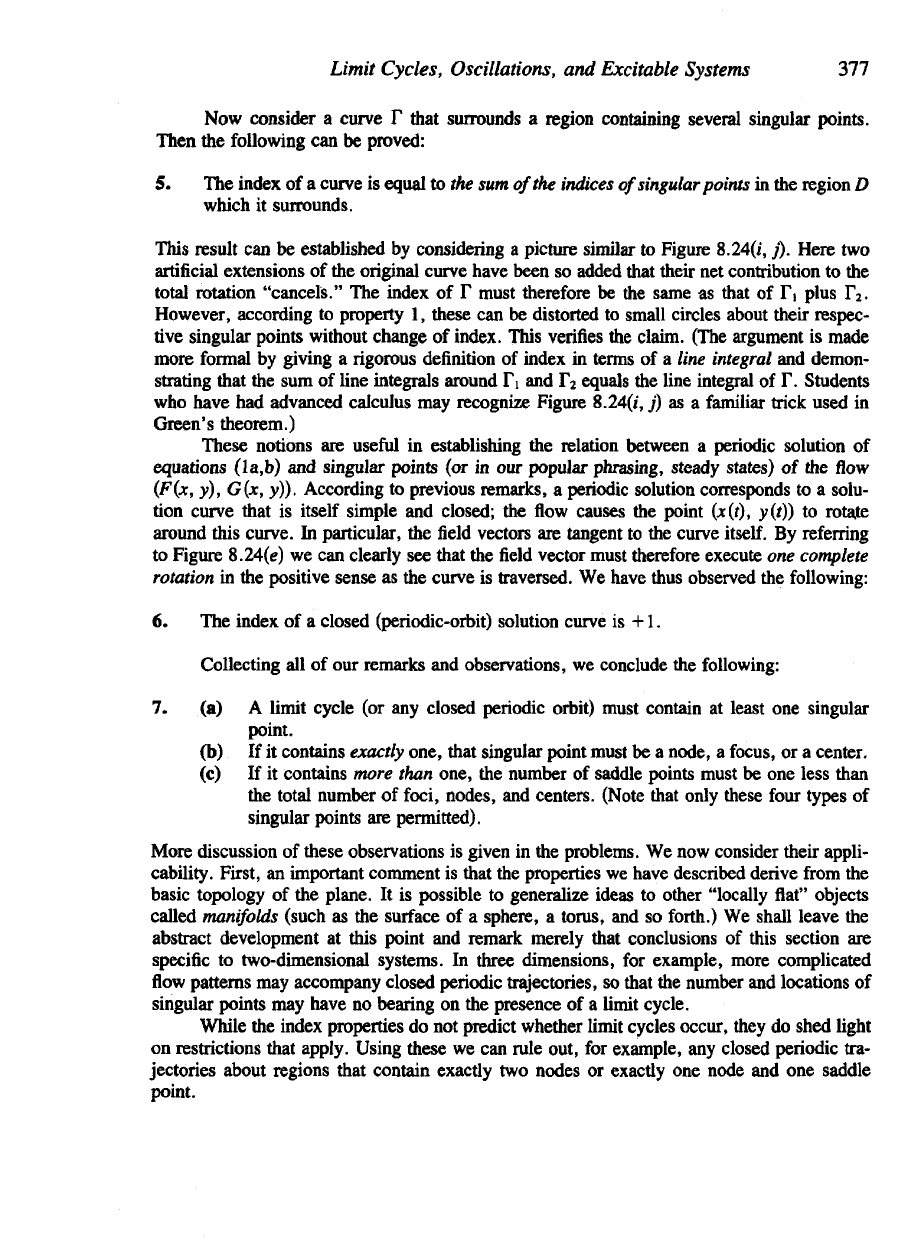
Limit
Cycles,
Oscillations,
and
Excitable
Systems
377
Now
consider
a
curve
F
that surrounds
a
region containing several singular points.
Then
the
following
can be
proved:
5. The
index
of a
curve
is
equal
to the sum
of
the
indices
of
singular
points
in the
region
D
which
it
surrounds.
This
result
can be
established
by
considering
a
picture similar
to
Figure
8.24(i,;').
Here
two
artificial
extensions
of the
original curve have been
so
added that their
net
contribution
to the
total rotation
"cancels."
The
index
of T
must
therefore
be the
same
as
that
of FI
plus
F
2
.
However, according
to
property
1,
these
can be
distorted
to
small circles
about
their respec-
tive singular points without change
of
index. This
verifies
the
claim. (The argument
is
made
more
formal
by
giving
a rigorous
definition
of
index
in
terms
of a
line
integral
and
demon-
strating that
the sum of
line integrals around
Fi and F
2
equals
the
line integral
of F.
Students
who
have
had
advanced calculus
may
recognize Figure
8.24(z,
j) as a
familiar
trick used
in
Green's theorem.)
These notions
are
useful
in
establishing
the
relation between
a
periodic solution
of
equations (la,b)
and
singular
points
(or in our
popular phrasing, steady
states)
of the flow
(F(x,
y),
G(x, y)). According
to
previous remarks,
a
periodic solution corresponds
to a
solu-
tion
curve
mat is
itself simple
and
closed;
the flow
causes
the
point
(x(t),
y(f))
to
rotate
around
this curve.
In
particular,
the field
vectors
are
tangent
to the
curve itself.
By
referring
to
Figure 8.24(e)
we can
clearly
see
that
the field
vector
must
therefore execute
one
complete
rotation
in the
positive sense
as the
curve
is
traversed.
We
have
thus
observed
the
following:
6. The
index
of a
closed
(periodic-orbit) solution curve
is +1.
Collecting
all of our
remarks
and
observations,
we
conclude
the
following:
7. (a) A
limit cycle
(or any
closed periodic orbit)
must
contain
at
least
one
singular
point.
(b) If it
contains
exactly
one, that singular point must
be a
node,
a
focus,
or a
center.
(c) If it
contains
more
than one,
the
number
of
saddle points
must
be one
less
than
the
total number
of
foci, nodes,
and
centers. (Note that only these
four
types
of
singular
points
are
permitted).
More discussion
of
these observations
is
given
in the
problems.
We now
consider their appli-
cability.
First,
an
important comment
is
that
the
properties
we
have described derive
from
the
basic topology
of the
plane.
It is
possible
to
generalize
ideas
to
other "locally
flat"
objects
called
manifolds
(such
as the
surface
of a
sphere,
a
torus,
and so
forth.)
We
shall leave
the
abstract development
at
this point
and
remark merely that conclusions
of
this section
are
specific
to
two-dimensional systems.
In
three dimensions,
for
example, more complicated
flow
patterns
may
accompany
closed
periodic trajectories,
so
that
the
number
and
locations
of
singular
points
may
have
no
bearing
on the
presence
of a
limit cycle.
While
the
index properties
do not
predict whether limit cycles occur, they
do
shed light
on
restrictions
that apply. Using
these
we can
rule out,
for
example,
any
closed
periodic
tra-
jectories
about regions that contain exactly
two
nodes
or
exactly
one
node
and one
saddle
point.
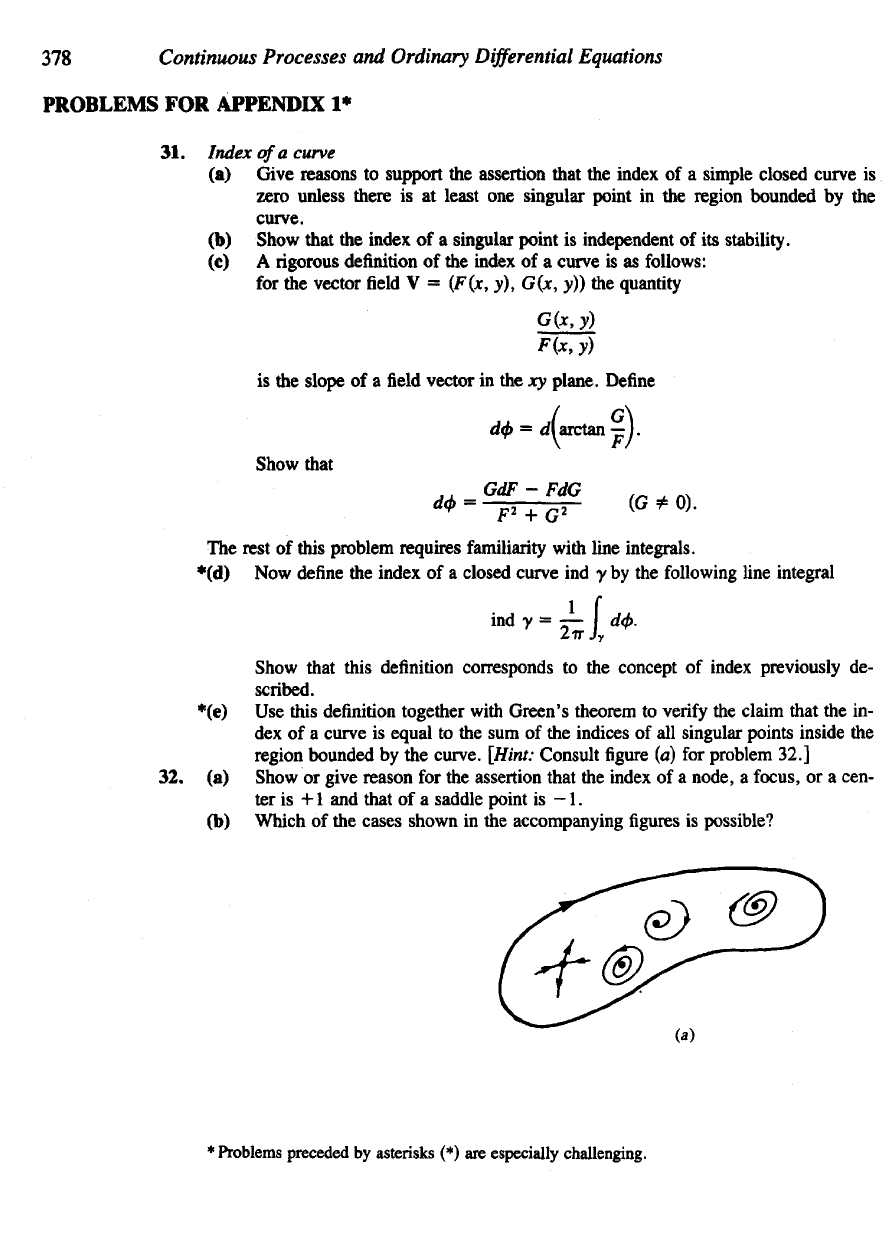
378
Co Processes
and
Ordinary
Differential
Equations
PROBLEMS
FOR
APPENDIX
1*
31.
Index
of
a
curve
(a)
Give
reasons
to
support
the
assertion
that
the
index
of a
simple
closed
curve
is
zero unless there
is at
least
one
singular point
in the
region bounded
by the
curve.
(b)
Show that
the
index
of a
singular point
is
independent
of its
stability.
(c) A
rigorous definition
of the
index
of a
curve
is as
follows:
for
the
vector
field V =
(F(x,
y),
G(JC,
y)) the
quantity
Show that
The
rest
of
this problem requires familiarity with line integrals.
*(d)
Now
define
the
index
of a
closed curve
ind y by the
following
line integral
Show that this
definition
corresponds
to the
concept
of
index
previously
de-
scribed.
*(e)
Use
this
definition
together
with
Green's
theorem
to
verify
the
claim that
the in-
dex of a
curve
is
equal
to the sum of the
indices
of all
singular points inside
the
region bounded
by the
curve.
[Hint:
Consult
figure (a) for
problem 32.]
32. (a)
Show
or
give
reason for the
assertion that
the
index
of a
node,
a
focus,
or a
cen-
ter
is +1 and
that
of a
saddle point
is -1.
(b)
Which
of the
cases
shown
in the
accompanying
figures is
possible?
*
Problems
preceded
by
asterisks
(*) are
especially challenging.
is the
slope
of a field
vector
in the xy
plane.
Define
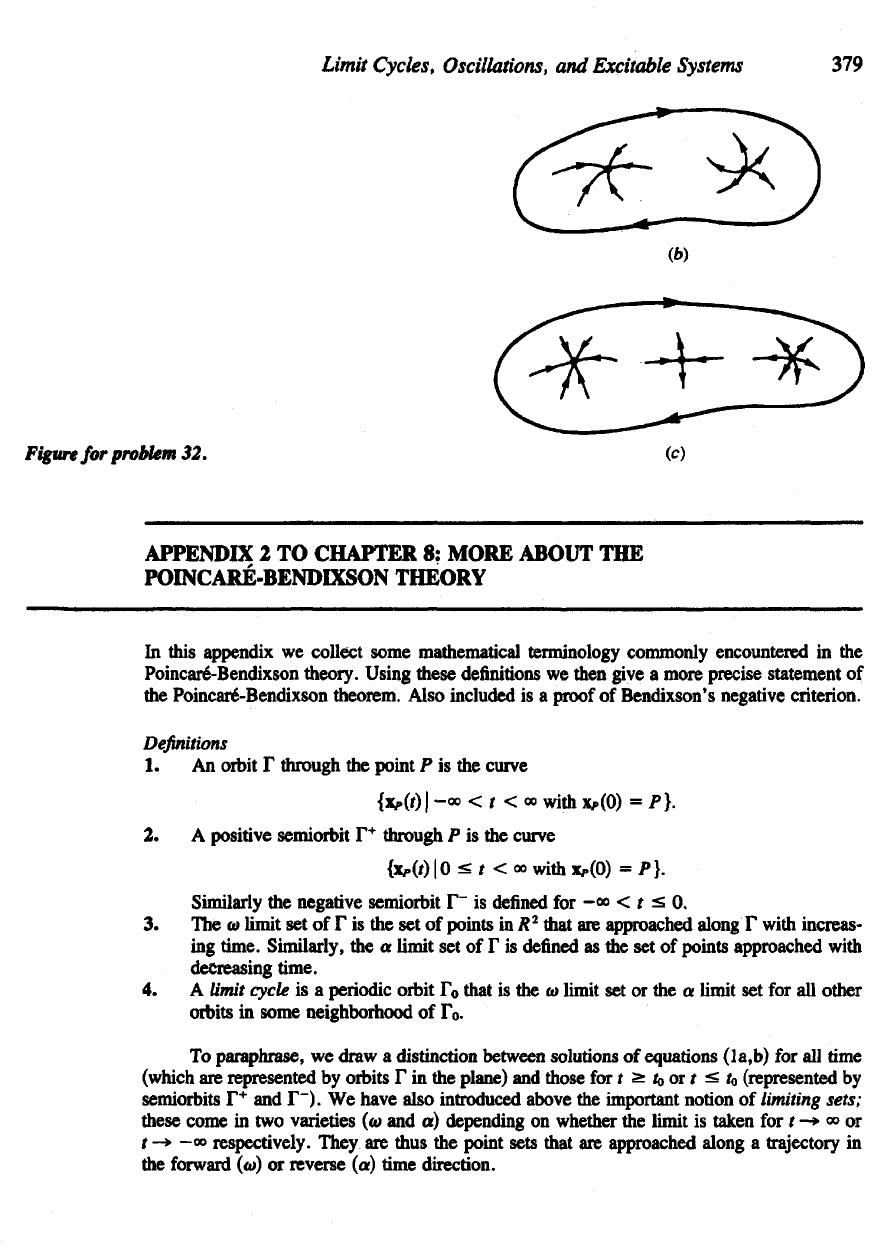
Limit
Cycles, Oscillations,
and
Excitable
Systems
379
Figure
for
problem
32.
APPENDIX
2 TO
CHAPTER
8:
MORE
ABOUT
THE
POINCARE-BENDIXSON
THEORY
Similarly
the
negative semiorbit
F is
defined
for -» < t ^ 0.
3. The «
limit
set of F is the set of
points
in R
2
that
are
approached along
F
with increas-
ing
time. Similarly,
the a
limit
set of F is
defined
as the set of
points approached with
decreasing time.
4. A
limit
cycle
is a
periodic orbit
F
0
that
is the
<o
limit
set or the a
limit
set for all
other
orbits
in
some neighborhood
of F
0
.
To
paraphrase,
we
draw
a
distinction
between solutions
of
equations (la,b)
for all time
(which
are
represented
by
orbits
F in the
plane)
and
those
for t ^ to or t ^ t
0
(represented
by
semiorbits
F
+
and
F~).
We
have also introduced above
the
important notion
of
limiting
sets;
these come
in two
varieties
(<o
and a)
depending
on
whether
the
limit
is
taken
for t
—»
» or
t
—»
—°°
respectively. They
are
thus
the
point sets that
are
approached along
a
trajectory
in
the
forward
(w) or
reverse
(a) time
direction.
In
this appendix
we
collect
some mathematical terminology commonly encountered
in the
Poincare-Bendixson
theory. Using these definitions
we
then give
a
more precise statement
of
the
Poincare-Bendixson theorem. Also included
is a
proof
of
Bendixson's negative criterion.
Definitions
1. An
orbit
F
through
the
point
P is the
curve
2. A
positive semiorbit
F
+
through
P is the
curve

380
Continuous Processes
and
Ordinary
Differential
Equations
A
limit cycle
is a
special periodic solution
of the
autonomous dynamic system
(la,b)
that
is
also simultaneously
a
limiting
set for
nearby trajectories. Physically this means that
for
t -» o° (or t
—>
-°°, depending
on
stability)
a
solution that starts
out
close
to the
periodic
so-
lution
will eventually
be
indistinguishable
from
it. (Of
course,
from
the
mathematical stand-
point
the two
will never
be
exactly equal during
finite time.)
We now
state
the
Poincare-Bendixson theorem, whose proof
is to be
found
in
numer-
ous
advanced books
on
ODEs (for example,
see
Hale,
1980):
Theorem
1: The
Poincare-Bendixson Theorem:
A
bounded semiorbit that does
not
approach
any
singular point
is
either
a
closed periodic orbit
or
approaches
a
closed periodic orbit.
Finally,
we
prove Bendixson's criterion (stated
in
Section 8.3) using Green's theorem.
A
Proof
of
Bendixson's
Criterion
The
quantity
dF/dx
+
dG/dy
will
not
have
a
vanishing integral over
S
unless
it
is
(1)
always zero
or (2)
alternately positive
and
negative
in 5.
This proves
the
theo-
rem.
so
that G(x,
y) dx =
F(x,
y) ay.
The
integral
of the LHS
above must therefore
be
zero,
forcing
the
conclusion that
where
5 is the
region contained within
the
curve
C.
For the
system
of
equations (la,b)
we
have
the
following relations:
Suppose
C is a
closed-curve trajectory
in the
simply connected region
D.
Then
b
Green's theorem
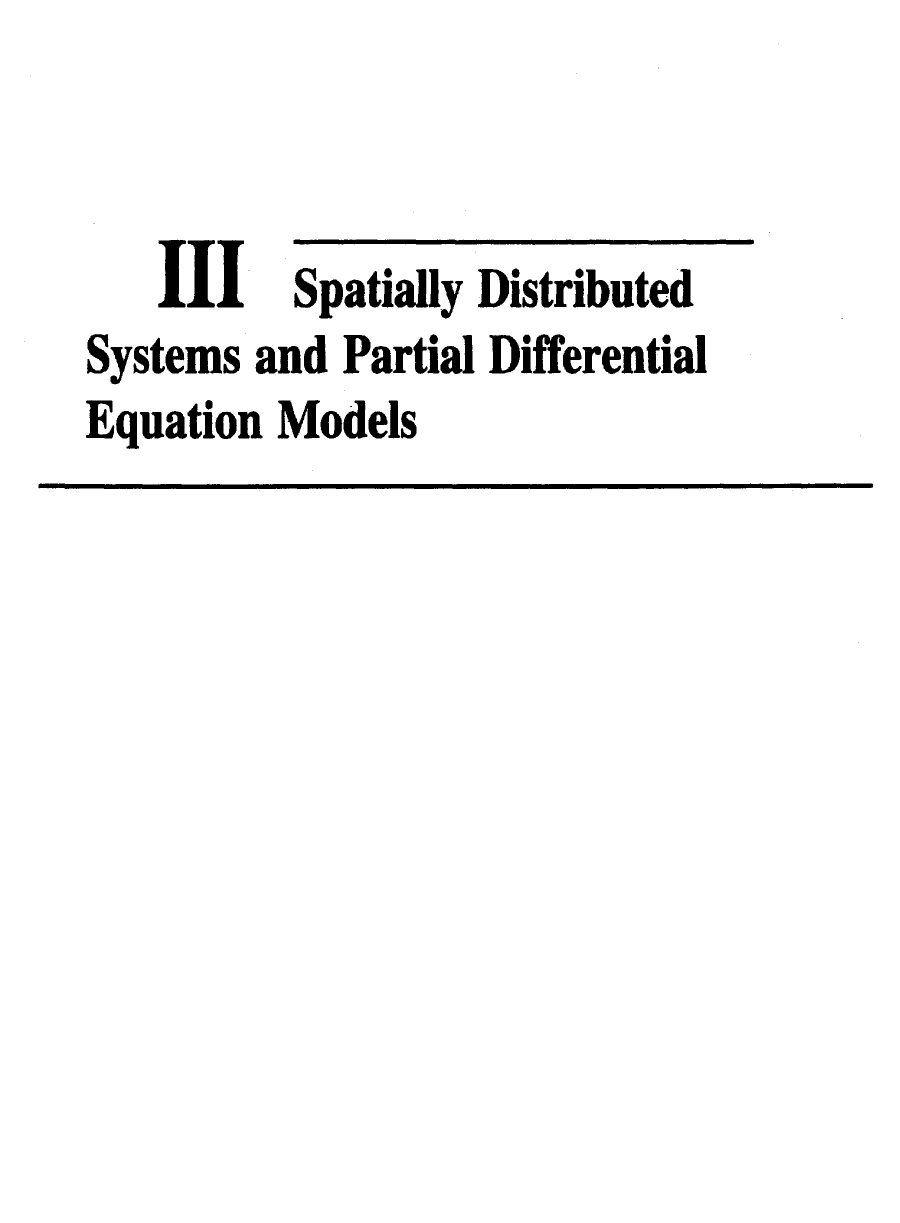
IllI Spatially Distributed
Systems
and
Partial
Differential
Equation Models

This page intentionally left blank
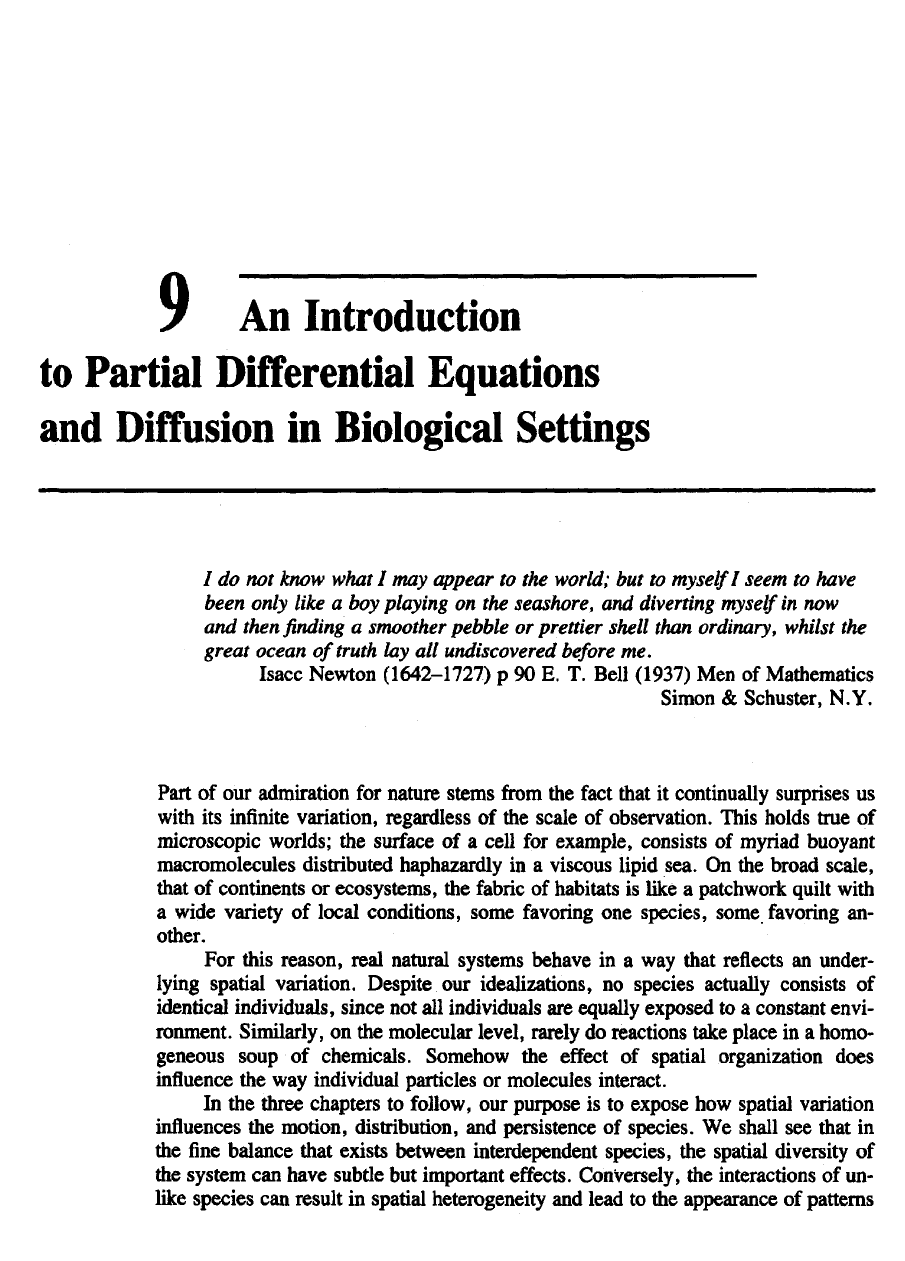
9
y An
Introduction
to
Partial
Differential
Equations
and
Diffusion
in
Biological
Settings
/ do not
know
what
I may
appear
to the
world;
but to
myself
I
seem
to
have
been
only
like
a boy
playing
on the
seashore,
and
diverting
myself
in now
and
then
finding a
smoother
pebble
or
prettier
shell
than
ordinary,
whilst
the
great
ocean
of
truth
lay all
undiscovered
before
me.
Isacc
Newton
(1642-1727)
p 90 E. T.
Bell (1937)
Men of
Mathematics
Simon
&
Schuster, N.Y.
Part
of our
admiration
for
nature stems
from
the
fact
that
it
continually surprises
us
with
its
infinite
variation, regardless
of the
scale
of
observation. This holds true
of
microscopic
worlds;
the
surface
of a
cell
for
example, consists
of
myriad buoyant
macromolecules
distributed haphazardly
in a
viscous lipid sea.
On the
broad scale,
that
of
continents
or
ecosystems,
the
fabric
of
habitats
is
like
a
patchwork quilt
with
a
wide variety
of
local
conditions, some
favoring
one
species,
some favoring
an-
other.
For
this reason, real natural systems behave
in a way
that
reflects
an
under-
lying
spatial variation. Despite
our
idealizations,
no
species actually consists
of
identical individuals, since
not all
individuals
are
equally exposed
to a
constant envi-
ronment.
Similarly,
on the
molecular level, rarely
do
reactions take place
in a
homo-
geneous
soup
of
chemicals. Somehow
the
effect
of
spatial organization does
influence
the way
individual particles
or
molecules interact.
In
the
three chapters
to
follow,
our
purpose
is to
expose
how
spatial variation
influences
the
motion, distribution,
and
persistence
of
species.
We
shall
see
that
in
the
fine
balance that exists between interdependent species,
the
spatial diversity
of
the
system
can
have subtle
but
important
effects.
Conversely,
the
interactions
of un-
like
species
can
result
in
spatial heterogeneity
and
lead
to the
appearance
of
patterns
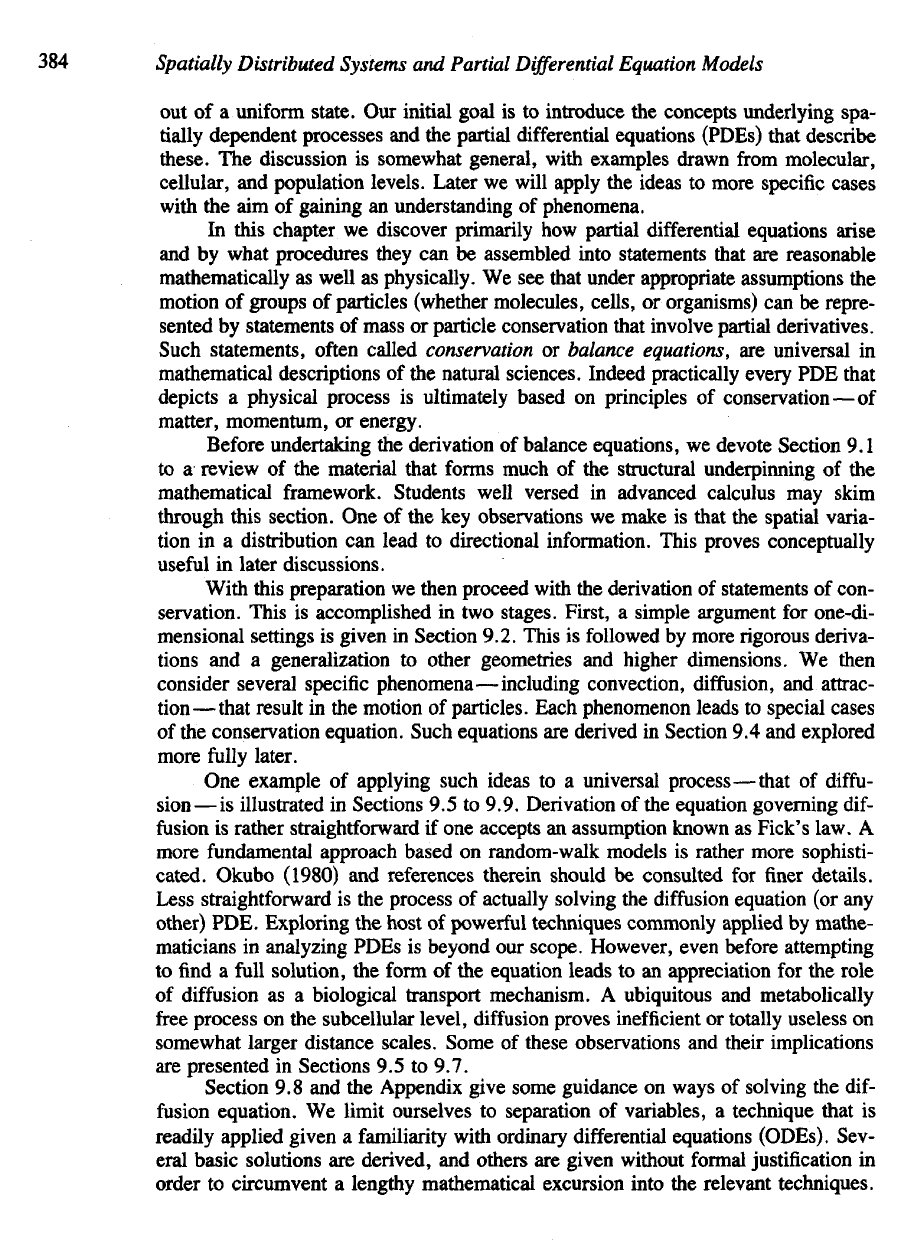
384
Spatially
Distributed
Systems
and
Partial
Differential
Equation
Models
out
of a
uniform
state.
Our
initial
goal
is to
introduce
the
concepts underlying spa-
tially dependent processes
and the
partial differential equations (PDEs) that
describe
these.
The
discussion
is
somewhat
general,
with examples drawn
from
molecular,
cellular,
and
population levels. Later
we
will apply
the
ideas
to
more specific cases
with
the aim of
gaining
an
understanding
of
phenomena.
In
this chapter
we
discover primarily
how
partial differential equations arise
and
by
what procedures they
can be
assembled into statements that
are
reasonable
mathematically
as
well
as
physically.
We see
that under appropriate assumptions
the
motion
of
groups
of
particles (whether molecules,
cells,
or
organisms)
can be
repre-
sented
by
statements
of
mass
or
particle conservation that involve partial derivatives.
Such
statements,
often
called conservation
or
balance equations,
are
universal
in
mathematical descriptions
of the
natural sciences. Indeed practically every
PDE
that
depicts
a
physical
process
is
ultimately based
on
principles
of
conservation—of
matter, momentum,
or
energy.
Before
undertaking
the
derivation
of
balance equations,
we
devote Section
9.1
to a
review
of the
material that forms much
of the
structural underpinning
of the
mathematical
framework. Students well versed
in
advanced calculus
may
skim
through this
section.
One of the key
observations
we
make
is
that
the
spatial varia-
tion
in a
distribution
can
lead
to
directional information. This proves conceptually
useful
in
later
discussions.
With
this preparation
we
then proceed with
the
derivation
of
statements
of
con-
servation. This
is
accomplished
in two
stages.
First,
a
simple argument
for
one-di-
mensional settings
is
given
in
Section 9.2. This
is
followed
by
more
rigorous
deriva-
tions
and a
generalization
to
other geometries
and
higher dimensions.
We
then
consider several specific phenomena—including convection,
diffusion,
and
attrac-
tion—that
result
in the
motion
of
particles. Each phenomenon leads
to
special cases
of
the
conservation equation. Such equations
are
derived
in
Section
9.4 and
explored
more
fully
later.
One
example
of
applying such ideas
to a
universal process—that
of
diffu-
sion—
is
illustrated
in
Sections
9.5 to
9.9. Derivation
of the
equation governing dif-
fusion
is
rather straightforward
if one
accepts
an
assumption known
as
Pick's
law.
A
more fundamental approach based
on
random-walk models
is
rather more sophisti-
cated.
Okubo
(1980)
and
references therein should
be
consulted
for finer
details.
Less straightforward
is the
process
of
actually solving
the
diffusion
equation
(or any
other) PDE. Exploring
the
host
of
powerful techniques commonly applied
by
mathe-
maticians
in
analyzing PDEs
is
beyond
our
scope. However, even before attempting
to find a
full
solution,
the
form
of the
equation
leads
to an
appreciation
for the
role
of
diffusion
as a
biological transport mechanism.
A
ubiquitous
and
metabolically
free
process
on the
subcellular
level,
diffusion
proves
inefficient
or
totally useless
on
somewhat
larger distance scales. Some
of
these observations
and
their implications
are
presented
in
Sections
9.5 to
9.7.
Section
9.8 and the
Appendix give some guidance
on
ways
of
solving
the
dif-
fusion
equation.
We
limit ourselves
to
separation
of
variables,
a
technique that
is
readily applied given
a
familiarity with ordinary
differential
equations (ODEs). Sev-
eral basic solutions
are
derived,
and
others
are
given without formal justification
in
order
to
circumvent
a
lengthy mathematical excursion into
the
relevant techniques.
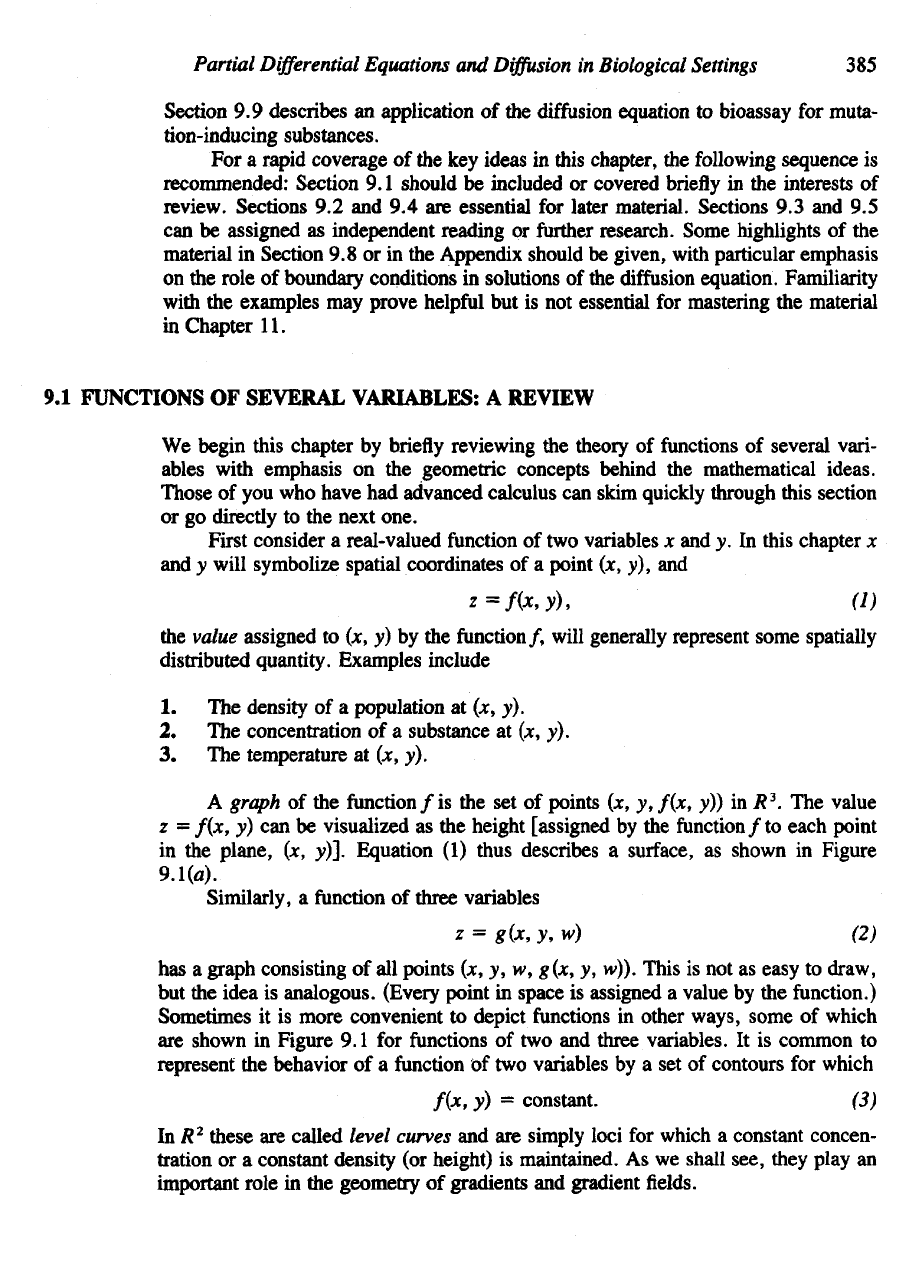
Partial
Differential
Equations
and
Diffusion
in
Biological
Settings
385
Section
9.9
describes
an
application
of the
diffusion
equation
to
bioassay
for
muta-
tion-inducing substances.
For a
rapid coverage
of the key
ideas
in
this chapter,
the
following sequence
is
recommended:
Section
9.1
should
be
included
or
covered
briefly
in the
interests
of
review.
Sections
9.2 and 9.4 are
essential
for
later material. Sections
9.3 and 9.5
can
be
assigned
as
independent reading
or
further
research. Some highlights
of the
material
in
Section
9.8 or in the
Appendix should
be
given, with particular emphasis
on
the
role
of
boundary conditions
in
solutions
of the
diffusion
equation. Familiarity
with
the
examples
may
prove
helpful
but is not
essential
for
mastering
the
material
in
Chapter
11.
In
R
2
these
are
called
level curves
and are
simply loci
for
which
a
constant concen-
tration
or a
constant density
(or
height)
is
maintained.
As we
shall see, they play
an
important
role
in the
geometry
of
gradients
and
gradient fields.
9.1
FUNCTIONS
OF
SEVERAL VARIABLES:
A
REVIEW
We
begin this chapter
by
briefly
reviewing
the
theory
of
functions
of
several vari-
ables with emphasis
on the
geometric concepts behind
the
mathematical ideas.
Those
of you who
have
had
advanced calculus
can
skim quickly through this section
or go
directly
to the
next one.
First
consider
a
real-valued
function
of two
variables
x and y. In
this chapter
x
and
y
will symbolize spatial coordinates
of a
point
(x, y), and
the
value assigned
to
(jc,
v) by the
function/, will generally represent some spatially
distributed quantity. Examples include
1. The
density
of a
population
at (*, y).
2. The
concentration
of a
substance
at (x, y).
3. The
temperature
at (x, y).
A
graph
of the
function/is
the set of
points (jc,
y,
f(x,
y)) in R*. The
value
z
=
f(x,
v) can be
visualized
as the
height
[assigned
by the
function
/ to
each point
in
the
plane,
(x,
y)]. Equation
(1)
thus describes
a
surface,
as
shown
in
Figure
9.1(fl).
Similarly,
a
function
of
three variables
has a
graph consisting
of all
points
(x, y, w,
g(x,
y,
w)). This
is not as
easy
to
draw,
but
the
idea
is
analogous. (Every point
in
space
is
assigned
a
value
by the
function.)
Sometimes
it is
more convenient
to
depict
functions
in
other ways, some
of
which
are
shown
in
Figure
9.1 for
functions
of two and
three variables.
It is
common
to
represent
the
behavior
of a
function
of two
variables
by a set of
contours
for
which
